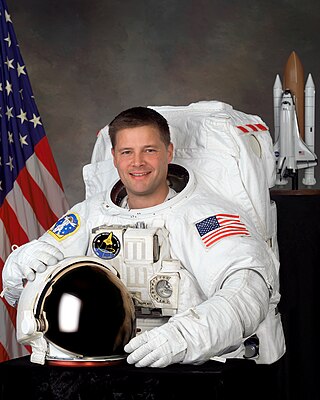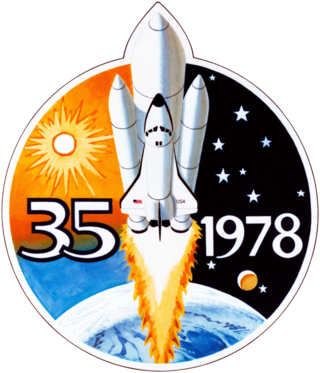Related Research Articles

An astronaut is a person trained, equipped, and deployed by a human spaceflight program to serve as a commander or crew member aboard a spacecraft. Although generally reserved for professional space travelers, the term is sometimes applied to anyone who travels into space, including scientists, politicians, journalists, and tourists.

Aleksandr "Sasha" Yuriyevich Kaleri is a former Russian cosmonaut and veteran of extended stays on the Mir Space Station and the International Space Station (ISS). Kaleri has most recently been in space in 2010 and 2011 aboard the ISS serving as a flight engineer for the long duration Expedition 25/26 missions. He has spent the fifth-longest time in space of any person, and the longest time in space of any person not born in what is now Russia.

Yury Valentinovich Lonchakov is a Russian former cosmonaut and a veteran of three space missions. He has spent 200 days in space and has conducted two spacewalks. From 2014 to 2017, Lonchakov served as head of the Yuri Gagarin Cosmonaut Training Center.

Sandra Hall Magnus is an American engineer and a former NASA astronaut. She returned to Earth with the crew of STS-119 Discovery on March 28, 2009, after having spent 134 days in orbit. She was assigned to the crew of STS-135, the final mission of the Space Shuttle. She is also a licensed amateur radio operator with the call sign KE5FYE. From 2012 until 2018 Magnus was the executive director of the American Institute of Aeronautics and Astronautics.

Norman Earl Thagard, is an American scientist and former U.S. Marine Corps officer and naval aviator and NASA astronaut. He is the first American to ride to space on board a Russian vehicle, and can be considered the first American cosmonaut. He did this on March 14, 1995, in the Soyuz TM-21 spacecraft for the Russian Mir-18 mission.

John Elmer Blaha is a retired United States Air Force colonel and a former NASA astronaut. He is a veteran of five space missions aboard the Space Shuttle and Mir.

Michael Allen Baker is a retired captain in the United States Navy, former NASA astronaut, and the International Space Station Program Manager for International and Crew Operations, at NASA's Johnson Space Center. He is responsible for the coordination of program operations, integration and flight crew training and support activities with the International Partners.

Kenneth Donald Cameron, , is a retired American naval aviator, test pilot, engineer, U.S. Marine Corps officer, and NASA astronaut.

Yuri Pavlovich Gidzenko is a Russian cosmonaut. He was a test cosmonaut of the Yuri Gagarin Cosmonaut Training Center (TsPK). Gidzenko has flown into space three times and has lived on board the Mir and the International Space Station. He has also conducted two career spacewalks. Although he retired on July 15, 2001, he continued his employment by a special contract until Soyuz TM-34 concluded. Since 2004 to May 2009, Gidzenko was the Director of the 3rd department within the TsPK. Since May 2009 he serves as the Deputy Chief of Cosmonaut Training Center TsPK.

Sergei Konstantinovich Krikalev is a Russian mechanical engineer, former cosmonaut and former head of the Yuri Gagarin Cosmonaut Training Center.

Salizhan Shakirovich Sharipov is a Kyrgyz cosmonaut of Uzbek descent. Sharipov is a co-author and investigator for the Advanced Diagnostic Ultrasound in Microgravity project. He has been to space twice and has conducted two space walks. Sharipov retired on 18 July 2008.

Yury Vladimirovich Usachov is a former cosmonaut who resides in Star City, Moscow. Usachov is a veteran of four spaceflights, including two long-duration missions on board the Mir Space Station and another on board the International Space Station. During his career, he also conducted seven spacewalks before his retirement on April 5, 2004.

The United States Astronaut Badge is a badge of the United States, awarded to military and civilian personnel who have completed training and performed a successful spaceflight. A variation of the astronaut badge is also issued to civilians who are employed with the National Aeronautics and Space Administration as specialists on spaceflight missions. It is the least-awarded qualification badge of the United States military.

The Shuttle–Mir program was a collaborative 11-mission space program between Russia and the United States that involved American Space Shuttles visiting the Russian space station Mir, Russian cosmonauts flying on the Shuttle, and an American astronaut flying aboard a Soyuz spacecraft to engage in long-duration expeditions aboard Mir.

Leonid Kostyantynovych Kadenyuk was the first astronaut of independent Ukraine who flew into outer space. He flew on NASA's Space Shuttle Columbia in 1997 as part of the international mission STS-87. Kadenyuk held the rank of major general in the Ukrainian Air Force. He was Deputy of Ukraine of the 4th convocation, People's Ambassador of Ukraine, Hero of Ukraine, President of the Aerospace Society of Ukraine, Adviser to the Prime Minister of Ukraine and Chairman of the State Space Agency of Ukraine, Honorary Doctor of Chernivtsi National University.

Douglas Harry "Wheels" Wheelock is an American engineer and astronaut. He has flown in space twice, logging 178 days on the Space Shuttle, International Space Station, and Russian Soyuz. On July 12, 2011, Wheelock announced that he would be returning to active duty with the United States Army in support of Operation Enduring Freedom. He is currently working with NASA to test the Orion spacecraft at the Glenn Research Center in Plum Brook, Ohio.

Satoshi Furukawa is a Japanese surgeon and JAXA astronaut. Furukawa was assigned to the International Space Station as a flight engineer on long-duration missions Expedition 28/29, lifting off 7 June 2011 and returning 22 November 2011.

Sergey Aleksandrovich Volkov is a retired Russian cosmonaut and engineer. He was a member of three missions to the International Space Station, spending more than a year in total in space. During his missions he did four spacewalks lasting more than 23 hours in total. Volkov retired from the Cosmonaut group in February 2017.

NASA Astronaut Group 8 was a group of 35 astronauts announced on January 16, 1978. It was the first NASA selection since Group 6 in 1967, and was the largest group to that date. The class was the first to include female and minority astronauts; of the 35 selected, six were women, one of them being Jewish American, three were African American, and one was Asian American. Due to the long delay between the last Apollo lunar mission in 1972 and the first flight of the Space Shuttle in 1981, few astronauts from the older groups remained, and they were outnumbered by the newcomers, who became known as the Thirty-Five New Guys (TFNG). Since then, a new group of candidates has been selected roughly every two years.
References
- ↑ Joe Engle flew on STS-2 without prior NASA spaceflight experience, but had flown the X-15 into space and had participated in the Shuttle Approach and Landing Tests.
- 1 2 "Astronauts | Career | Education | Pilot | Commander | Mission Specialist | NASA | Space Shuttle | Flight – Page 1". Kidzworld.com. Retrieved 2012-06-09.
- ↑ Bolden, Charles F. (2004-01-06). "Charles F. Bolden". NASA Johnson Space Center Oral History Project (Interview). Interviewed by Johnson, Sandra; Wright, Rebecca; Ross-Nazzal, Jennifer. Houston, Texas. Retrieved 6 January 2014.
- 1 2 "Astronauts | Career | Education | Pilot | Commander | Mission Specialist | NASA | Space Shuttle | Flight – Page 2". Kidzworld.com. 2008-10-07. Retrieved 2012-06-09.
- ↑ "NASA – Space Shuttle Columbia and Her Crew". Nasa.gov. 2006-03-05. Retrieved 2012-06-09.
- ↑ "Launch America: NASA, SpaceX to Launch First Astronauts to Space Station from U.S. Since 2011". nasa.gov. National Aeronautics and Space Administration. Retrieved 18 April 2020.
- 1 2 McHale, Suzy. "RuSpace – Suzy's Russian space site". Suzymchale.com. Archived from the original on 2020-07-26. Retrieved 2012-06-09.
- ↑ Lei, Zhao. "18 picked for nation's 3rd generation of astronauts". China Daily. Retrieved 9 October 2020.
- 1 2 林芷瑩 (3 October 2022). "何謂載荷專家 在太空站要從事什麼工作?". HK01 (in Chinese).

